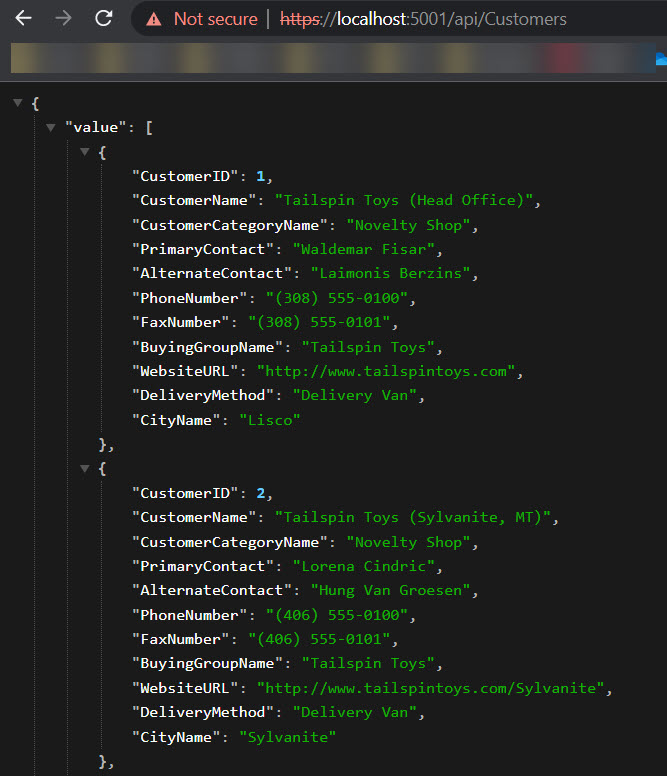Install the DAB CLI
Create a SQL database with an empty database.
$sid="<your subcription identifier here>"
$rg="<resource group name>"
$administratorPassword="__Holasql4320"
az login
az account set --subscription $sid
# create sql instance and empty database
$result = az deployment group create --resource-group $rg --template-file ./infra/sqldb.bicep --parameters administratorLoginPassword=$administratorPassword | ConvertFrom-Json
# read output values
$sqlServerName = $result.properties.outputs.sqlname.value
$databaseName = $result.properties.outputs.dbname.value
$administratorLogin = $result.properties.outputs.administratorLogin.value
Seed the database with the WideWorldImporters SQL sample.
$bacpac="https://github.com/Microsoft/sql-server-samples/releases/download/wide-world-importers-v1.0/WideWorldImporters-Standard.bacpac"
$localpath="/bacpac/WideWorldImporters-Standard.bacpac"
$sto="holadabcli"
# create storage account
az storage account create --name $sto --resource-group $rg --location westeurope --sku Standard_LRS
# create container
az storage container create --name sql --account-name $sto
# get connection string
$cn = az storage account show-connection-string --name $sto --resource-group $rg --query "connectionString" -o tsv
# upload bacpac to storage account
az storage blob upload --account-name $sto --connection-string $cn --container-name sql --type block --file $localpath
# get storage access key
$key = az storage account keys list --account-name $sto --resource-group $rg --query [0].value -o tsv
# restore bacpac (can take up to 30 mins)
az sql db import -s $sqlServerName -n $databaseName -g $rg -u $administratorLogin -p $administratorPassword --storage-key-type StorageAccessKey --storage-key $key --storage-uri "https://$sto.blob.core.windows.net/sql/WideWorldImporters-Standard.bacpac"
Get the connecton string to the SQL database and initialize the DAB tool.
https://learn.microsoft.com/en-us/azure/data-api-builder/get-started/get-started-azure-sql
$sqlCN = az sql db show-connection-string --server $sqlServerName --name $databaseName --client ado.net -o tsv
$sqlCN = $sqlCN.replace('<username>',$administratorLogin).replace('<password>',$administratorPassword)
# initialize the DAB config file
dab init --database-type "mssql" --connection-string $sqlcn --host-mode "Development"
# add the Customers entity (view)
dab add Customers --source Website.Customers --permissions "anonymous:read" --source.type "view"
dab start
you can now check the API hosted on localhost:5000
# run the aca.sh script
sh aca.sh
The script is creates:
- resource group
- log analytics
- container registry (not used in this example)
- storage account (persistent volume for aca)
- create file share
- upload dab config file to share
- container apps environment
- mount file share on container apps environment
- create container apps application
Before completing, the aca.sh script print out the last steps to complete this exercise.
step 1 - save the ACA application configuration to a YAML file (e.g. edit-volume.yaml)
az containerapp show -n dabfirstsight-customers -g rg-dabfirstsight -o yaml > edit-volume.yaml
step 2 - update the YAML to introduce volumes, volumeMounts and args
# the relevant changes are volumes, volumeMounts and args
containers:
- image: mcr.microsoft.com/azure-databases/data-api-builder:latest
name: dabfirstsight-customers
args:
- "--ConfigFileName=./dabconfig/dab-config.json"
volumeMounts:
- volumeName: azure-files-volume
mountPath: /App/dabconfig
volumes:
- name: azure-files-volume
storageType: AzureFile
storageName: dabconfig
step 3 - update the ACA application
res=$(az containerapp update -n dabfirstsight-customers -g rg-dabfirstsight --yaml edit-volume.yaml)
step 4 - check the status of the ACA revision
az containerapp revision list -n dabfirstsight-customers -g rg-dabfirstsight -o table
The new revision is up an running and the previous revision is eventually phased out.

